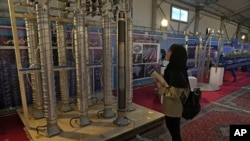Leaders of the Group of Seven (G7) industrialized democracies expressed “grave concern” about the growing security threat posed by Iran’s escalation of its nuclear program and its destabilizing role in the region and beyond.
In a communiqué adopted in Hiroshima, Japan, on May 19-21, G7 leaders said that the Islamic Republic “must never develop a nuclear weapon,” and that Iran’s “unabated escalation of its nuclear program” has “no credible civilian justification and brings it dangerously close to actual weapon-related activities.”
Iran responded by calling the accusations “baseless and fabricated.”
“As repeatedly stated before, Iran's nuclear program has only peaceful purposes, and nuclear weapons have no place in the Iranian defense doctrine,” Iranian Foreign Ministry Spokesman Nasser Kanaani said.
That is misleading.
While Iran did reportedly stop its decades-long effort to build a nuclear bomb in 2003, the G7 is correct in saying Iran has enriched uranium to levels that have no legitimate civilian use.
The Institute for Science and International Security (ISIS), a Washington D.C.-based think tank, said that rather than possessing “a traditional nuclear weapons program,” Iran’s previous nuclear weapons program readied it to make nuclear weapons “on demand.”
“Today, Iran is closer to being able to build nuclear weapons than it was in 2003 at the end of the Amad Plan, its large-scale nuclear weapons program in the early 2000s,” ISIS founder David Albright wrote.
In the past, Albright served as a nuclear inspector for the International Atomic Energy Agency (IAEA), the United Nations watchdog that checks compliance with the Nuclear Non-Proliferation Treaty.
In September 2002, the IAEA said Iran had enough uranium enriched near weapons grade to make an atomic bomb.
In June 2022, the IAEA censured Iran for failing to provide a credible explanation for how the uranium traces ended up at three undeclared locations.
Iran responded by removing 27 IAEA cameras monitoring its nuclear activity and saying the cameras would stay off until the 2015 Joint Comprehensive Plan of Action, under which Tehran agreed to curtail much of its nuclear program in exchange for sanctions relief, was restored.
In November 2022, the IAEA passed a resolution calling on Iran “to cooperate fully and in a timely manner” with the agency’s investigation into those unexplained uranium traces.
That month, Iran announced it was enriching Uranium to 60% at its secretive underground Fordow nuclear plant.
Sixty percent is technically not far from weapons-grade uranium, which is enriched to roughly 90%.
The IAEA said Iran had already been enriching uranium up to 60% at its Natanz enrichment plant since April 2021.
A top U.S. defense official said Iran’s nuclear progress has been “remarkable” since former U.S. President U.S. Donald Trump withdrew from Joint Comprehensive Plan of Action.
“Back in 2018, when the previous administration decided to leave the [Joint Comprehensive Plan of Action], it would have taken Iran about 12 months to produce one bomb's worth of fissile material. Now it would take about 12 days," Under Secretary of Defense for Policy Colin Kahl told U.S. lawmakers in late February.
While U.S. President Joe Biden declared the Joint Comprehensive Plan of Action dead in December 2022, Axios reported in April that the White House has discussed an interim deal with partners that would see Iran halt some parts of its nuclear program in exchange for sanctions relief.
The Stockholm International Peace Research Institute (SIPRI), which analyses disarmament and arms control issues, said that while 60% enriched uranium cannot be used to make an atomic bomb, “Iran has no other realistic use for this material.”
“Cascades of centrifuges are designed to enrich uranium in steps; Iran’s centrifuges are likely set up to enrich up to 20%, from 20-to-60%, and from 60-to-90%. Assuming the 60%-enriched uranium is stored in the form of uranium hexafluoride (UF6) gas—and there would be no point in Iran converting it to any other chemical form—the enrichment step from 60%-enriched to weapons-grade uranium is very short,” SIPRI said.
SIPRI said enrichment to 60% “was not an arbitrary choice,” adding it was likely “intended to send a political message.”
In February, two diplomats told Reuters the IAEA had discovered uranium enriched to 84% at its Fordow site.
Iran told the IAEA that may have resulted from “unintended fluctuations in enrichment.”
In March, the IAEA and Iran reached a deal to reinstall some of the surveillance equipment at Iran’s nuclear sites.
But Kelsey Davenport, Director for Nonproliferation Policy at the Washington, D.C.-based Arms Control Association, said the IAEA has not clarified “if Iran will permit the agency to install an online enrichment monitor at the Fordow enrichment facility.”
Japanese Prime Minister Fumio Kishida, a native of Hiroshima, which the U.S. dropped an atomic bomb on in WWII, used the symbolic venue to call out Russia for threatening the use of nuclear weapons.
The G7 also called out Iran for reportedly transferring drones that have been used “to attack Ukraine’s critical infrastructure and kill Ukrainian civilians.”
While Iran and Russia have both denied Tehran was supplying Moscow with such weapons, Ukraine has ample evidence that Russia is using Iranian-built drones to prosecute its war.







